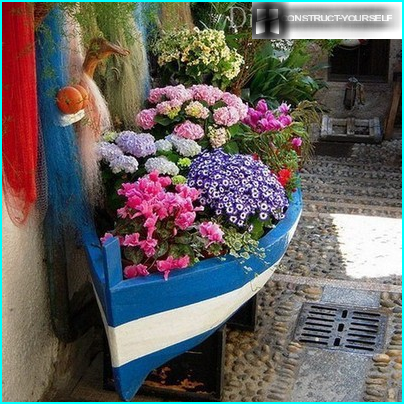
Private home water outside a centralized system, based on water supply from Autonomous sources — wells, bore-holes or from a tank (rarely). Feature underground sources is the lack of pressure needed to lift water to the top. Therefore, for the continuous provision of land or buildings to purchase governing the installation to supply water — pumping station or in other words, pressure tank for a private home.
The contents
Sale of pumping equipment based on the based on the characteristics of all parts of the system, their compatibility, compliance to a specific source (well or borehole) and on the choice of location for installation. Installation of pumping station can be made at various stages: during the construction of the house, drilling a well or repair work.
For installation you will need a closed flat ground minimum size (1-1. 5 m?), located in the utility room, the basement or on the street. If the best place do you think the angle in the house (bathroom, porch), then take care of good insulation, even if the equipment is equipped with the necessary certificates.
Aspect #1 — device equipment
Still equally actively use two types of hydrophores:
- membrane, equipped with a flexible airtight membrane which separates the compartments with water and compressed air;
- membraneless, in which water and compressed air are not separated, are in the same tank.
The membrane is a dense rubber bag is not in contact with the walls of its container. Hydrophores with the membrane device compact, are smaller and do not require large area for installation – ideal for homes with a shortage of free space. The volume of the tank – an average of 30-50 liters, but if necessary it is possible to find the 80 and 100 litre models.
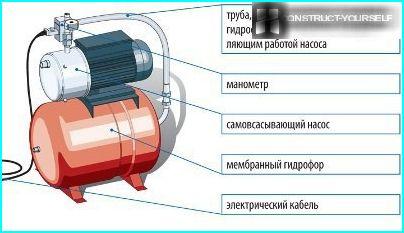
Diagram of pump station with membrane tank equipped with self-priming pump and water pressure sensor, from the testimony which depends the operation of the pump
Self-priming motor is mounted on top (small models, the volume – is set to close) and connects with the tank elastic pipe. To adjust the pressure of compressed air is used the nipple. Thanks to the constructive characteristics of the diaphragm device produces less noise. In some models, the possibility of replacing a worn membrane. If you have to buy a spare, make sure it is certifying, as the material (usually rubber) comes in contact with drinking water.
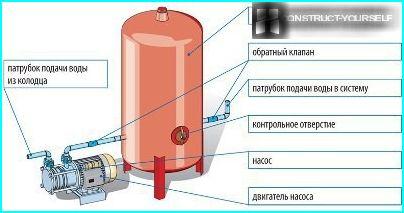
Scheme of the pumping station with a free tank having the form of a big tank on legs: the bottom part of the tank is water, in the upper – compressed air
Free tank – a large vertically oriented cylinder whose volume of 100 liters and more. For water supply complete with a free tank need to buy self-priming pump vortex type. Optimal pump pressure must not exceed 0.6 MPa, since this figure is the maximum for a greater number of hydrophores.
Normative standards allow for the use of pumps with high pressure, but with the installation of the safety valve, a drain which leads into the sewer.
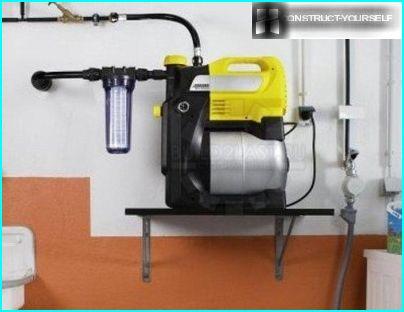
For better functioning of the tank and protect it from breakage in the pipe before the filter device is mounted an additional water purification
The correct choice hydrophore equipment depends on the stabilization of the pressure in the device and the entire water supply system, the optimum pressure in each point of demand (in the kitchen faucet, in the shower, for watering the garden), protection from heavy loads.
It should be remembered that the work of the hydrophore based on two factors:
- the indicators of pressure;
- the volume of water used.
That is, the amount of starts per hour may be different.
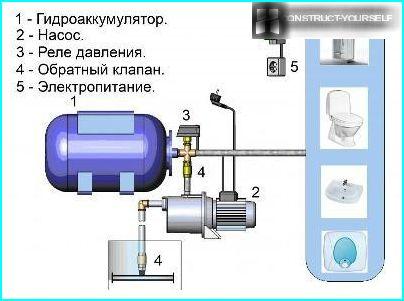
The standard scheme hydrophore: water fills the storage tank until relay pressure; the pump is activated again after draining the tank and raising the pressure within the tank
Consider how pressure affects the launch. Suppose that in the house turned on the faucet. The volume of water inside the device began to decrease and the cushion of compressed air, on the contrary, to increase, which causes a decrease in pressure. Once the pressure reached the lowest level, automatically activates the pump and pumps water up to the moment when the air volume is reduced, therefore the pressure will not rise. The pressure switch responds and switches off the pump. The maximum rate of pressure inside the tank is set by the manufacturer of the equipment, but the operation of the relay can be controlled independently.
Aspect #2 — the volume and pressure of the unit
The main factor to rely on when choosing the volume of the accumulator, the average amount of water consumed by the family. Performance is calculated based on the amount of water wasted in 1 hour. There are averages, but they are usually mistaken for at least. For example, a family of 4 people residing in a small private house required a tank with a capacity of 2-3M?/h a Large family living in a two storey cottage with garden plot, it should rely on productivity of not less than 7-8 m?/h.
In addition to the dry counting number of residents to consider their way of life: some wash once a week, others daily. A number of household machines and devices are also powered by water – washing machine and dishwasher, hot and shower system, automatic watering lawn or garden.
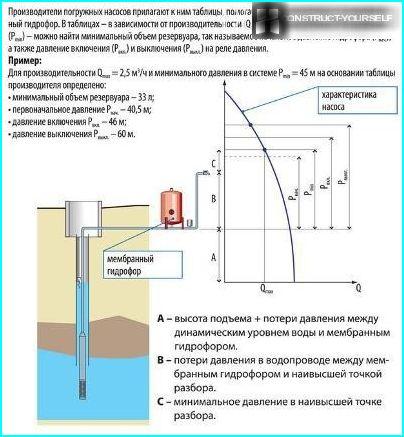
Table offered by manufacturers is designed for installation professionals If you are not able to independently understand the schemes, contact the experts in installation of systems of water supply
However, it should be taken into account and the maximum pressure created by the pump. As a rule, the new tank comes with a user manual, which serves as a hint: in the table the manufacturer specifies a list of important values that need to be guided during the installation of the equipment. Working pressure must meet all of the devices included in the water system. These include devices that are installed in most private homes — different types of water heaters (storage or tankless), boilers, single or dual circuit, balerno equipment.
The pressure put upon the connection of the equipment manually, by means of regulating bolts, but strictly according to instructions. For example, the pressure of the pump is 1.7 bar pressure pump – 3.0 bar.
Aspect #3 — source water intake
The choice of tank depends on the source of water abstraction, which are:
- well;
- well;
- water;
- pond;
- tank.
To raise water from a well or a well, requires a powerful pump. It works continuously, including during the analysis of water and off when the house is closed all the taps. It helps to adjust a pressure switch – an adjustable tool that allows you to control the water flow by increasing or reducing pressure.
You can use two versions of the pump. One of them, the pump pressure, creates pressure and thus sucks up the water, but it has limitations. In addition to depth (up to 7-8 meters) must be considered and the horizontal portions: 10 meters horizontal pipe = one and a half meters vertical pipe down in the well.
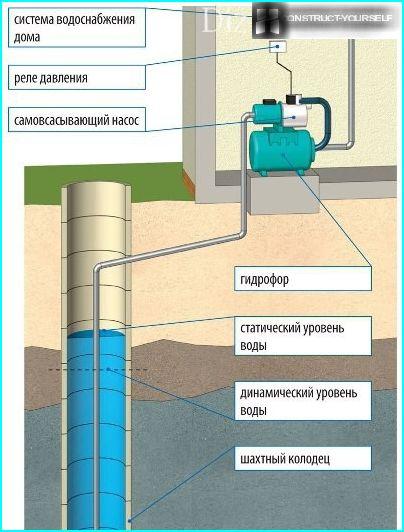
The scheme of taking water from well or well with the help of self-priming pump. This method has limitations – the maximum depth of no more than 8 meters
When the water level is too low, hydrophore set directly in the keyhole tooling platform at the required height. High humidity even with a good waterproofing can bring equipment down ahead of time, therefore, this method is used only in a desperate situation. Ideal for setting – a dry, warm, specially equipped basement.
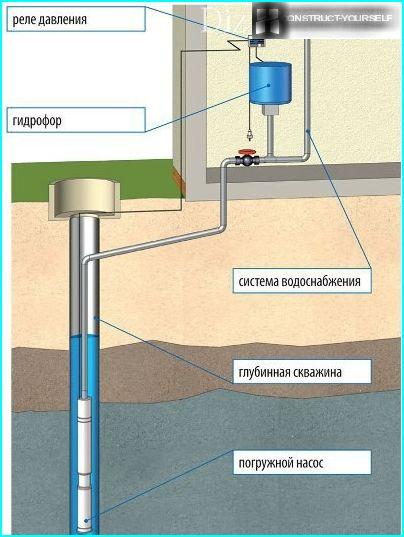
The scheme of work of pump station, performing water extraction using submersible pump. Most of the wells has a depth of 20-40 meters, which demonstrated the relevance of this method
Oddly enough, in small houses the pumps fail often. This happens for one reason: the number of starts of the equipment more as gaining water often but in small quantities. Each model pump has a control value of the maximum inclusion within one hour, for example, 25-30 inclusions per hour. If the tenants will use the water more often in the first place come out of the engine due to overheating. To avoid breakage, it is necessary to increase the switch interval – this is one of the most important functions of the tank.
For homes located within the city or village, usually connected to a centralized water supply system. However, due to the small pressure often water is not supplied to the second floor, so forced-feed also need a pump station. Pressure tank complete with vortex pump should be connected directly to the water supply. The pressure was constant, it is better to choose a motor with inverter control.
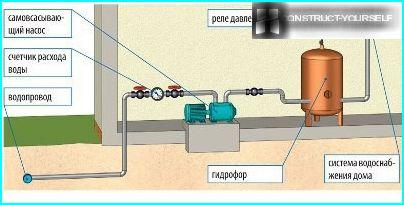
Diagram of pumping equipment at water intake from the water. The advantage of this method is to stabilize the water flow in low pressure centralized system
Thus, hydrophores optimal for use in private houses and cottages with such water sources, like shallow wells, unstable water, or ponds for watering the garden.
Aspect #4 — the conditions and place of installation
The compact size of modern equipment allow it to be installed virtually in any suitable corner in the bathroom, on the terrace, in the back room, in the hallway, and even under the sink in the kitchen. The noise level may be different, and for large figures, of course, will require additional insulation.
Establishing a pumping station, should be aware of the standards and requirements for installation of electrical and water supply systems in private homes. Some of the rules relate to the premises for installation of the equipment:
- the room area – not less than 2 m x 2.5 m;
- height of room not less than 2.2 m;
- minimum distance from tank to wall is 60 cm;
- the minimum distance from pump to wall – 50 cm.
The requirements not only for pumping equipment, but to all associated systems. All electrical cable, the occasion, the lamps, the lamps must have a high degree of protection from moisture. The room temperature must not be freezing, the best option is +5?C to +25?With.
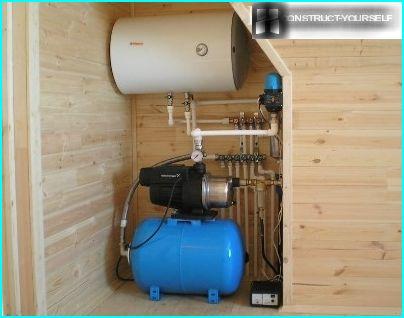
In a large house there are no problems with the placement of the tank: often it is installed together with other pump equipment in a special room, providing easy access for maintenance and repair
Obligatory ventilation, which provides constant cooling of the engine. Insurance emergency accident – the slope of the floor and sewer openings with a bandwidth equal to the pump output. Even the door unit must comply with the installed equipment, if necessary, can easily make, or to make the largest element of the pumping station.
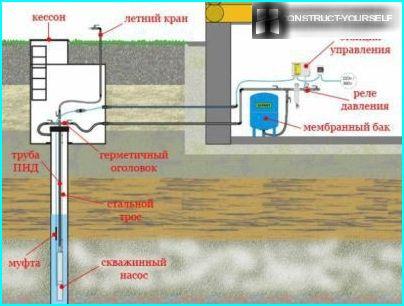
One of the best accommodation options of the pumping equipment is in the basement of a residential building, the role of which can also play a cellar or basement
If the vibration and noise level of the tank exceeds the standards, or simply prevent to live, his stand outside the building and placed in concrete well – insulated and sealed a small hole in the ground. To protect the walls from crumbling, use concrete with reinforced mesh, reinforced waterproof tape. For insulation used polystyrene, stacked layers is thinner than 5-8 cm.
The role of the ceiling plays a concrete slab, and a door – hatch hermetically lockable. Rainwater can penetrate into the cracks, so the top hatch cover with sheets of roofing felt or a plastic waterproof cover. In sale there are designer options, masking sewage and maintenance hatches, they are made in the form of stones or of grass.
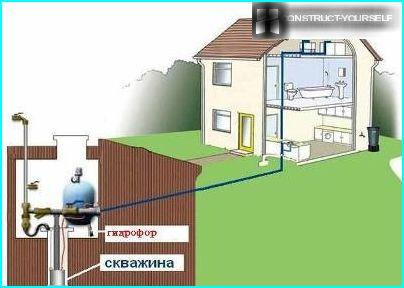
If the tank is installed directly in the well or sump, it is necessary to protect the equipment against the penetration of water, make a free access to engine and pump, to warm the room
The descent into the pit is accessed by a ladder mounted on the wall. All the conditions are similar to requirements of accommodation in the utility room will need lighting, ventilation, sewage sludge and insulation (especially in Northern regions). It should be remembered that the engine of the pumping station not protected from flooding, so the threat to users. All these nuances should be taken into account at the stage of purchase and selection of equipment.






